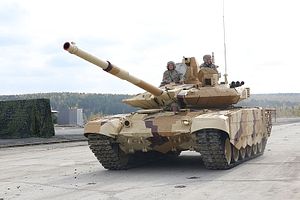India’s Cabinet Committee on Security (CCS), headed by Indian Prime Minister Narendra Modi, has approved a $1.93 billion procurement of 464 Russian-made T-90MS main battle tanks (MBTs) for service in the Indian Army earlier this month.
The signing of a final contract between the Indian Ministry of Defense (MoD) and Russia’s arms export agency, Rosoboronexport, could take place in the coming months. However, according to Defense News, it is unlikely that the MoD will sign the contract unless Russian tank maker Uralvagonzavod increases local production of the T-90MS MBT from 40 percent to 80 percent.
According to Indian Army officers, cited by IHS Jane’s, the new MBTs will be delivered in kit form for assembly by India’s state-owned Heavy Vehicles Factory (HVF), a subdivision of the Ordnance Factories Board, in Avadi in southeastern India. The officers stated that the T-90MS acquisition became necessary due to delays in the license-production of the T-90S Bhishma MBT.
While the HVF signed contracts in 2006 and 2007 to build 1,000 T-90S Bhishma MBTs, to date under 400 have been delivered to the Indian Army, which the first batch of 10 inducted into service with the Indian Army in 2009. Since the early 2000s, the HVF has also assembled 400-450 T-90S tanks imported from Russia in kit form. “Till now India has received 310 plus 347 T-90 tanks from Russia, whether fully formed or assembled in [the HVF],” a defense official was quoted as saying by Defense News.
Russia delivered the first T-90S MBTs to India in January 2004. There are currently around 1,000-1,100 T-90 MBTs of both the MS and Bhishma S variants in service, although the operational readiness rate of the tanks remains unclear. According to one estimate, 850-900 are of the T-90S Bhishma variant. Of the two, the T-90MS MBT is the more advanced design.
The MoD’s Defense Acquisition Council approved the procurement of the 464 MS MBTs in November 2016. The new tanks are expected to form the core of 10 armored regiments. The Indian Army currently fields over 3,000 MBTs divided into around 65 armored regiments. As I noted elsewhere:
The backbone of the force remains 1,900 T-72M1 Ajeyas imported in the 1980s, 1,500 of which are slated to be retrofitted with more powerful engines, new fire control systems, reactive armor, fire detection and suppression systems, as well as new communication and navigation systems under the Combat Improved Ajeya program, code-named Project Rhino.
The service also deploys the Arjun MK-I tank, an indigenously developed MBT based on the German Leopard II tank design, of which anywhere from 80 to 124 are currently operational.
“India’s MoD issued a global request for information (RFI) in November 2017 to develop and build 1,770 armored fighting vehicles, principally to replace the Indian Army’s T-72 MBTs in the next decade,” I wrote in October 2018. “A request for proposal (RFP), the next stage in the procurement process, however, has not been issued to date.”
































